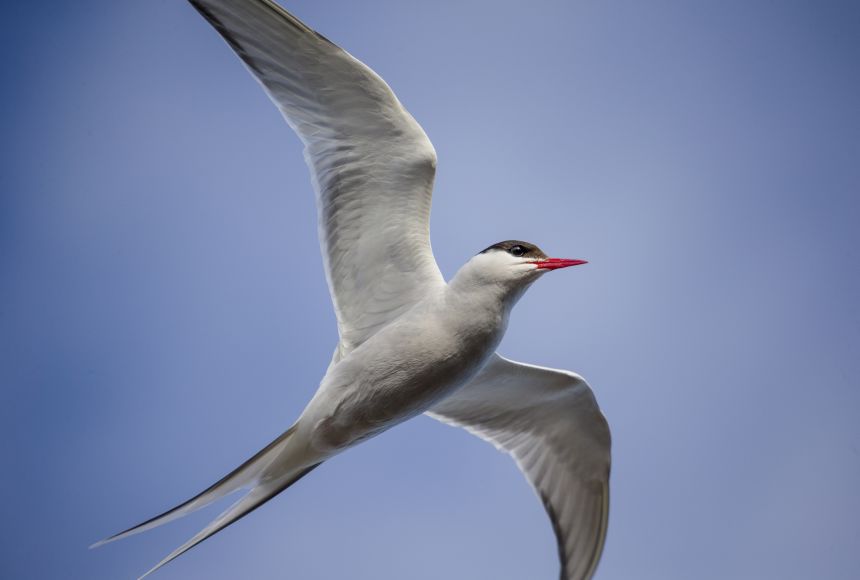Migration is a natural phenomenon observed in species across the animal kingdom, from the tiniest insects to the gargantuan blue whale (Balaenoptera musculus). Every year, millions of animals set out on an epic journey in search of food, shelter, and mating opportunities. Often travelling thousands of miles by land, sea, or air, these animals push the limits of endurance.
Frequent Flyer
Arctic terns (Sterna paradisaea) are small, plain-looking birds, weighing between 90–120 grams (3.2–4.2 ounces) with a wing span of 64–76 centimeters (25.2–29.9 inches). To the untrained eye, they do not look as if they are built for endurance, but these birds take the trophy for the longest migration of any animal in the world.
Flying from pole to pole, Arctic terns spend most of their year at sea chasing a perpetual summer. Seasons are reversed in the Northern and Southern hemispheres, so as winter approaches in their Arctic breeding grounds, the terns head south to the Antarctic where summer is just beginning. Arctic terns are believed to migrate around 40,000 kilometers (25,000 miles) a year, but a recent scientific study suggests that they might fly double that distance.
Multigenerational Relay
Perhaps one of the most famous migrations is the multi-generational round trip of the monarch butterfly. Monarch butterflies (Danaus plexippus) can be found all over the United States and further afield, but it is the northeastern American population that is famous for making the 4,800-kilometer (3,000-mile) journey from Canada to Mexico.
Each year, millions of monarch butterflies leave their northern ranges and fly south to the oyamel fir forests near the Sierra Madre mountains, where they gather in huge roosts to survive the winter. When spring arrives, the monarchs start their return journey north; the population cycles through three to five generations to reach their destination. Along the way, females lay eggs on milkweed plants, which the caterpillars use for food after hatching. This new generation of butterflies complete the journey their great-great-great-grandparents started. It is still a mystery to scientists how the new generations know where to go, but they appear to navigate using a combination of the Earth’s magnetic field and the position of the sun.
The Great Migration
Wildebeest (Connochaetes taurinus) take the crown for the most dramatic migration. Wildebeest (also known as gnu) are members of the antelope family, but they look more like cows with their big horns, stocky build, and shaggy manes. They live in huge groups of over one million individuals, along with thousands of zebras (Equus quagga) and gazelles (Eudorcas thomsonii). During the dry season, this giant herd roams the Serengeti-Mara ecosystem of Tanzania and Kenya in search of fresh grass and water. It is a round-trip that spans hundreds of miles and two countries. The herd moves as a great swarm, and individuals must keep up or risk being picked off by the lions (Pantera leo), hyenas (Crocuta crocuta), and crocodiles (Crocodylus niloticus) that gather to hunt.
Slow and Steady Wins the Race
Humpback whales (Megaptera novaeangliae) are one of the largest animals on the planet, weighing in at an impressive 36,000 kilograms (79,366 pounds). Fully grown adults can reach 18 meters (59 feet) in length and can live over 48 years. These giants spend their summers at feeding grounds in cold, nutrient-rich waters that support an abundance of krill and small fish. In the winter, they migrate to warmer waters to raise their calves and avoid predation by killer whales.
It is a journey that can take over 8,000 kilometers (4,970 miles) each way, making it the longest migration of any mammal on Earth. Humpback whales are slow swimmers, but they make up for it by traveling non-stop for days at a time. They do not feed along their migration route and instead survive on fat reserves built up during the summer months.
Endurance Athlete
There is one species of Atlantic salmon (Salmo salar) and seven species of Pacific salmon. Salmon spend most of their lives in the Atlantic and Pacific Oceans, where they feed and grow before migrating back to the rivers where they were born. Salmon swim across the ocean to the mouth of the river, navigating using a combination of chemical cues, the sun, and Earth’s magnetic field. To reach their final destination, the salmon must swim up the river, in an event known as ‘the salmon run’. In an incredible feat of endurance, they swim up to 400 kilometers (250 miles) against the current, battling rapids and leaping up waterfalls, all while avoiding predators that congregate along the banks in hopes of catching a nutritious meal. When Pacific salmon (but not Atlantic salmon) finally reach their birthplace, they spawn and then die.
Animal migration has fascinated humans for centuries. Scientists have shed light on some of the enduring mysteries about how species navigate and what drives them to leave a habitat, but we still have a lot to learn. These incredible journeys are certainly captivating, but they also have a vital role to play in the ecosystem. Migration affects the distribution of prey and predators, keeps nutrients cycling around the planet, helps with the spread of pollen and seeds, and even influences human economies. Animal migrations are impressive, but they are also essential for a healthy ecosystem and, ultimately, a healthy planet.
